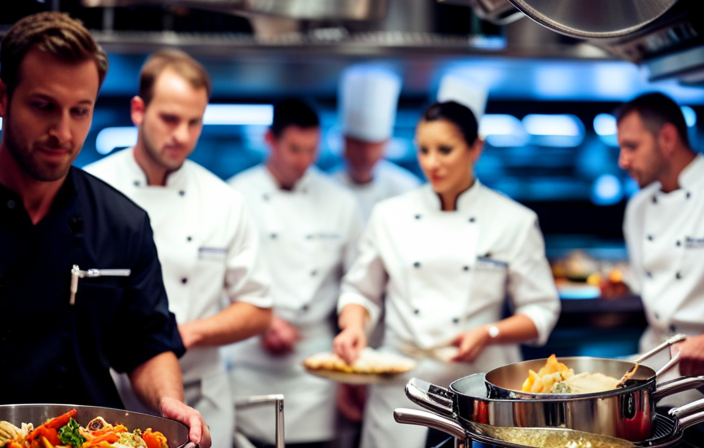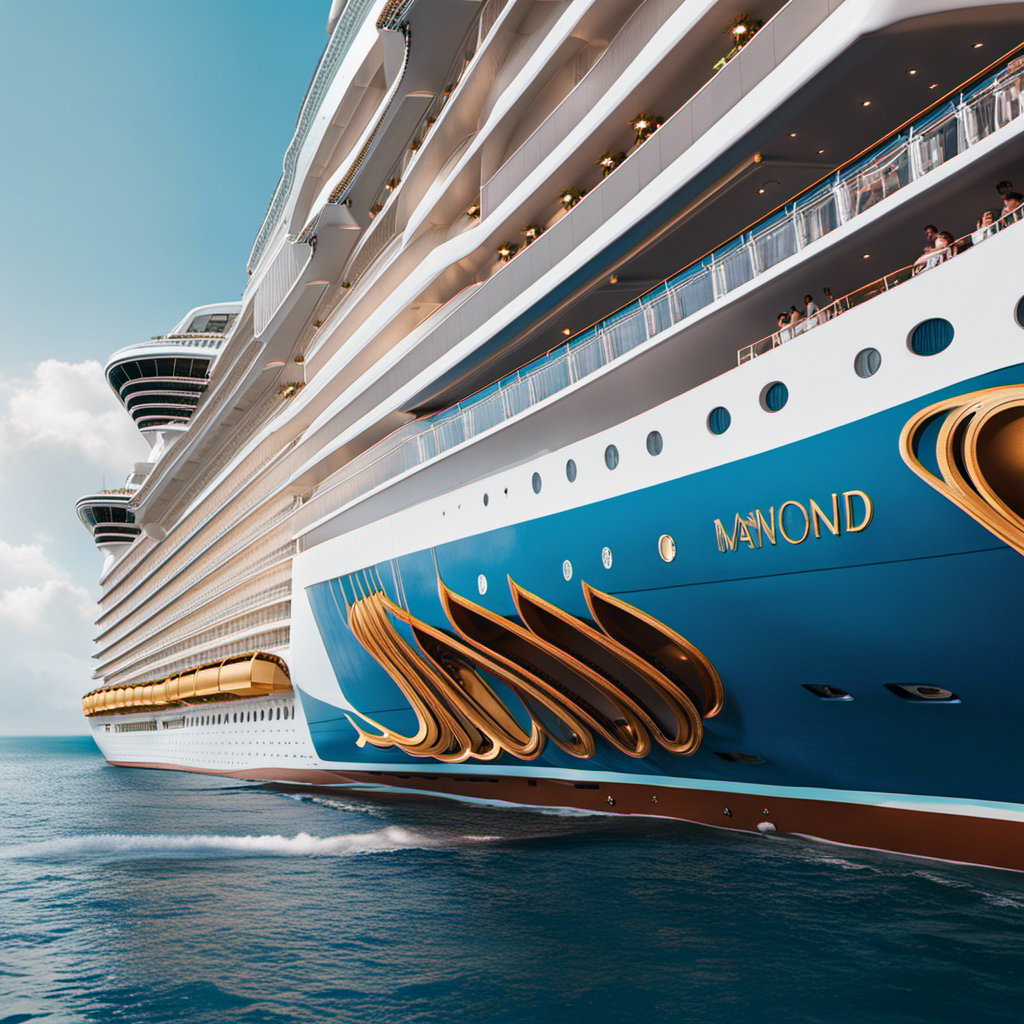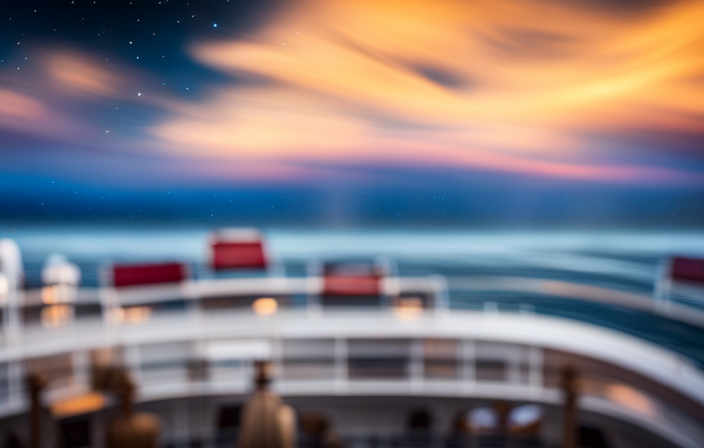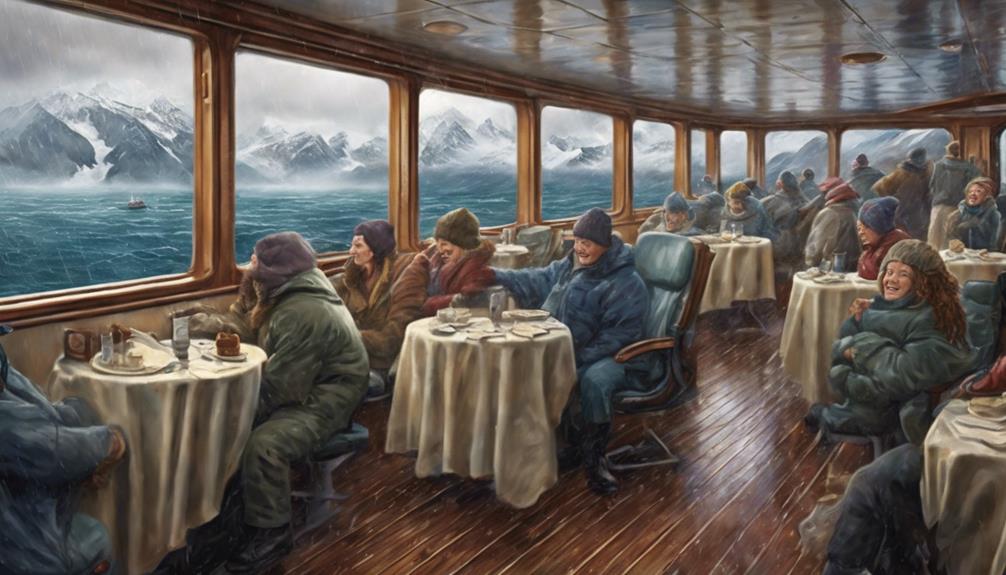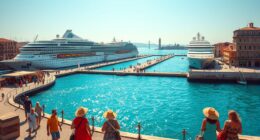Picture a lively cruise ship bustling with the echoes of cheerful laughter, enchanting melodies, and the enticing scent of mouthwatering food drifting in the breeze. As passengers partake in lavish meals and tempting delights, it is inevitable that some food will remain uneaten.
But have you ever wondered what happens to all that leftover food? Well, let me take you behind the scenes and reveal the fascinating world of what cruise ships do with their surplus meals.
From food donation programs that make a difference in local communities, to innovative recycling and composting initiatives, cruise ships are on a mission to minimize waste and maximize sustainability.
Onboard, the culinary team creatively repurposes food, ensuring that nothing goes to waste. And don’t forget about the hardworking crew members and staff who also enjoy the spoils of these leftovers.
Additionally, some cruise lines have animal feeding programs, where surplus food is donated to local wildlife.
Join me as we delve into the fascinating realm of how cruise ships handle their leftover food with utmost responsibility and care.
Key Takeaways
- Cruise ships have food donation programs and partnerships with local organizations to distribute excess food and reduce food waste.
- Sustainability efforts on cruise ships include implementing composting and recycling practices to minimize the environmental impact of the cruise industry.
- Onboard food reuse and creative cooking techniques are employed to repurpose leftovers into new dishes and minimize food waste.
- Waste management practices and sustainability initiatives on cruise ships involve repurposing leftovers, promoting food waste awareness, and implementing efficient inventory management systems to track ingredient usage and prevent waste.
Food Donation Programs
You’ll be happy to know that cruise ships have food donation programs in place to make sure that leftover food doesn’t go to waste! These programs aim to address the issue of food surplus on board by partnering with local organizations and communities during port visits.
Through these initiatives, cruise ships are able to engage in community outreach by donating excess food to those in need. The surplus food is carefully collected, sorted, and distributed to local food banks or charities. This not only helps to reduce food waste but also supports the communities in the ports of call.
In addition to food donation programs, cruise ships also prioritize sustainability by implementing composting and recycling practices for organic waste and packaging materials. This ensures that the environmental impact is minimized while also transitioning into the subsequent section about composting and recycling.
Composting and Recycling
When it comes to composting and recycling on cruise ships, there are several key points to consider.
First, turning food waste into compost is an effective way to reduce waste and create nutrient-rich soil for future use.
Additionally, recycling food packaging helps to minimize the environmental impact of the cruise industry.
Lastly, implementing sustainable waste management practices is crucial for ensuring a greener and more eco-friendly cruising experience.
Turning food waste into compost
Although it may seem challenging, cruise ships can effectively turn their leftover food into nutrient-rich compost, helping to reduce waste and contribute positively to the environment. This is achieved through various composting initiatives and waste reduction strategies implemented on board.
Here are some key points to understand the process:
- Food waste is collected and stored separately from other types of waste.
- The waste is then processed through a composting system that relies on microorganisms to break down the organic matter.
- Composting requires the right balance of carbon and nitrogen-rich materials, such as leaves, grass clippings, and food scraps.
- The resulting compost is used to enrich the ship’s gardens or donated to local communities.
By composting leftover food, cruise ships are able to minimize their environmental impact and create a valuable resource from what would otherwise be wasted. Moving on to recycling food packaging, cruise ships also prioritize sustainable practices to further reduce their ecological footprint.
Recycling food packaging
Transforming food packaging into reusable materials is a sustainable practice that allows cruise ships to minimize waste and contribute positively to the environment. As part of their food waste management, cruise ships are increasingly adopting sustainable packaging options.
These include using biodegradable containers made from materials like cornstarch or sugarcane, as well as utilizing recyclable materials such as aluminum cans and glass bottles. By implementing these sustainable packaging choices, cruise ships not only reduce the amount of waste generated but also decrease their reliance on single-use plastics.
This move towards sustainable packaging aligns with the industry’s commitment to environmental stewardship and conservation. It is an essential step in creating a more eco-friendly cruise experience.
Moving forward, sustainable waste management practices on cruise ships encompass more than just recycling food packaging.
Sustainable waste management practices
Sustainable waste management practices on cruise ships encompass more than just recycling food packaging; they also involve implementing composting systems to reduce organic waste. Interestingly, a study found that by composting food scraps, cruise ships can reduce their overall waste volume by up to 30%.
To effectively manage food waste on board, cruise ships have adopted various sustainable practices:
-
Source separation: Crew members separate food waste from other types of waste to ensure proper disposal.
-
Composting: Organic waste is processed into nutrient-rich compost, which can be used for gardening and landscaping on the ship.
-
Waste-to-energy conversion: Some cruise ships use advanced technologies to convert food waste into renewable energy, reducing their reliance on fossil fuels.
-
Waste audits: Regular assessments are conducted to identify areas where waste reduction and recycling efforts can be improved.
-
Partnerships with local communities: Cruise ships collaborate with local organizations to donate excess food and reduce waste.
These food waste management practices not only benefit the environment but also contribute to the overall sustainability efforts on board.
Transitioning to the next section, onboard food reuse is another vital aspect of sustainable cruise ship operations.
Onboard Food Reuse
When it comes to onboard food reuse, cruise ships have found ways to repurpose leftovers into new dishes. This not only helps to minimize food waste but also allows for creativity in the kitchen.
In addition, cruise ships often create daily specials using excess ingredients, ensuring that nothing goes to waste. By employing creative cooking techniques, cruise ships are able to minimize food waste and provide passengers with delicious meals throughout their voyage.
Repurposing leftovers into new dishes
Did you know that cruise ships have a clever way of repurposing their leftover food into delicious new dishes? To minimize food waste and implement waste reduction strategies, cruise ships often repurpose their excess ingredients by creating a variety of exciting dishes. Instead of throwing away perfectly good food, the onboard chefs get creative and transform leftovers into new culinary creations. They utilize a range of techniques, such as combining different leftover ingredients to make unique salads, soups, and pasta dishes. They also repurpose leftover proteins, like chicken or fish, into delicious tacos or sandwiches. By repurposing their leftover food, cruise ships not only reduce waste but also offer guests a chance to try innovative and flavorful meals. Speaking of repurposing, let’s explore how cruise ships create daily specials from excess ingredients.
Creating daily specials from excess ingredients
After learning about how cruise ships repurpose leftovers into new dishes, let’s dive into another fascinating way they minimize food waste through creative cooking. One way cruise ships tackle this challenge is by creating daily specials from excess ingredients. This not only helps to utilize leftovers but also adds variety to the menu and keeps guests excited about the culinary offerings on board.
Here are three ways cruise ships turn excess ingredients into delicious daily specials:
-
Chef’s Surprise: The chef uses a combination of leftover ingredients to create a unique and flavorful dish that changes daily.
-
Catch of the Day: Leftover seafood is transformed into mouthwatering seafood specials, ensuring the freshest ingredients are used.
-
Veggie Delight: Excess vegetables are creatively incorporated into vegetarian specials, offering a healthy and sustainable option for guests.
By repurposing leftovers into daily specials, cruise ships demonstrate their commitment to minimizing food waste through creative cooking. Now, let’s explore more ways they achieve this goal in the subsequent section.
Minimizing food waste through creative cooking
To minimize food waste, you can get creative in the kitchen by transforming excess ingredients into mouthwatering dishes that will surprise and delight your taste buds. One way to do this is by utilizing a variety of cooking techniques and flavor combinations. For example, you can turn leftover vegetables into a vibrant stir-fry by sautéing them with garlic and soy sauce. Another option is to make a hearty soup using leftover meats, vegetables, and broth. Additionally, you can repurpose stale bread into delicious breadcrumbs or croutons. By thinking outside the box and experimenting with different ingredients, you can reduce food waste while still enjoying flavorful meals. As we explore crew meals and staff consumption, it’s important to understand how these creative cooking methods contribute to the overall sustainability efforts onboard.
Crew Meals and Staff Consumption
Utilizing leftovers for crew meals is an important practice on cruise ships. It not only helps to reduce food waste but also ensures that the crew members are well-fed and taken care of. By repurposing leftover food, we can make the most out of our resources and ensure that nothing goes to waste onboard.
Utilizing leftovers for crew meals
You can make use of leftover food on cruise ships by repurposing it for the meals of the crew members. This not only helps to reduce food waste but also promotes food waste awareness and encourages creative menu planning.
Here are some ways in which leftovers can be utilized for crew meals:
- Leftover proteins can be transformed into delicious stir-fries or casseroles.
- Vegetables can be used to create hearty soups or flavorful salads.
- Stale bread can be turned into tasty croutons or breadcrumbs for use in other dishes.
- Excess fruit can be used to make refreshing smoothies or fruit salads.
By repurposing leftovers for crew meals, cruise ships can minimize food waste while ensuring that their staff members are well-fed. This approach contributes to a more sustainable and efficient food management system on board.
Moving forward, let’s explore how cruise ships can further reduce food waste through staff consumption.
Reducing food waste through staff consumption
After learning about how cruise ships utilize leftovers for crew meals, I was curious to find out more about how they reduce food waste through staff consumption.
It turns out that staff engagement plays a crucial role in this process. Cruise ships encourage their staff to actively participate in reducing food waste by promoting portion control. This means that the staff is educated on the importance of only taking what they can consume and avoiding excessive portions. By doing so, they not only reduce food waste but also ensure that everyone gets a fair share of the meals.
This approach creates a sense of responsibility among the staff to be mindful of their food consumption and contributes to a more sustainable environment onboard. However, reducing waste through staff consumption is just one aspect of ensuring nothing goes to waste onboard.
Ensuring nothing goes to waste onboard
To ensure nothing goes to waste onboard, it’s important to implement efficient inventory management systems that track and monitor the usage of ingredients and supplies. By utilizing a digital inventory management system, cruise ship staff can easily keep track of expiration dates and ingredient quantities, allowing for proactive measures to be taken to prevent waste.
This includes adjusting purchasing orders based on consumption patterns and creating menus that utilize ingredients nearing expiration. Additionally, cruise ships can implement sustainable practices such as composting food scraps and donating excess food to local charities. These initiatives not only minimize food waste but also contribute to the overall sustainability efforts of the cruise industry.
Transitioning into the subsequent section about animal feeding programs, these initiatives ensure that even unused food finds a purpose onboard.
Animal Feeding Programs
During animal feeding programs, we distribute our leftover food to various animals on board. This practice not only helps us reduce waste but also contributes to animal rehabilitation and wildlife conservation efforts. We carefully select the type and quantity of food to ensure it meets the dietary needs of each animal.
Leftover fruits and vegetables are often given to herbivores, while meat scraps are provided to carnivorous animals. The animals eagerly await their meals, and it’s heartwarming to see them enjoy the food.
By participating in these programs, we contribute to the well-being of the animals on board and support wildlife conservation initiatives.
Moving on to waste-to-energy conversion, we have implemented innovative methods to further reduce our environmental impact.
Waste-to-Energy Conversion
Through waste-to-energy conversion, you can witness the transformative power of turning our ship’s waste into a source of energy, symbolizing our commitment to sustainability and reducing our environmental footprint.
Waste to energy alternatives are innovative solutions that allow us to efficiently manage the waste generated on board. By utilizing advanced technologies, we’re able to convert organic waste, such as leftover food, into renewable energy sources like electricity and heat.
This process not only helps us minimize the amount of waste sent to landfills but also reduces greenhouse gas emissions.
Our waste management innovations ensure that we make the most out of our resources while prioritizing eco-friendly practices.
As we delve into the topic of port disposal regulations, it’s important to understand how these waste-to-energy conversion systems align with the industry’s efforts to promote responsible waste management.
Port Disposal Regulations
Navigating port disposal regulations can be a challenge, but understanding and complying with them is crucial for ensuring responsible waste management practices. Port regulations vary from one location to another, making it important for cruise ships to familiarize themselves with the specific requirements of each port they visit.
These regulations often dictate how waste should be separated, stored, and disposed of, to minimize the impact on the environment. Some key points to consider when dealing with port disposal regulations include:
- Properly sorting waste into designated categories such as food waste, recyclables, and hazardous materials.
- Adhering to specific storage and containment guidelines for different types of waste.
- Complying with reporting and documentation requirements to track waste disposal activities.
- Collaborating with local waste management facilities to ensure proper disposal and treatment of waste.
Understanding and complying with these regulations helps cruise ships minimize their environmental footprint and promote sustainable waste management practices. It also fosters collaboration between the cruise industry and local communities to address waste management challenges.
Transitioning into the next section, education and awareness play a crucial role in further improving waste management practices.
Education and Awareness
Education and awareness are key in transforming waste management practices and sparking a waste revolution that will leave the world in awe. When it comes to cruise ships and their leftover food, food waste awareness plays a crucial role.
By educating crew members and passengers about the impact of food waste on the environment, sustainable food practices can be encouraged. This can include portion control, proper storage and preservation techniques, and composting.
Implementing these practices not only reduces the amount of food waste generated on board but also promotes a more sustainable and responsible approach to food consumption.
By creating a culture of awareness and responsibility, cruise ships can play a significant role in minimizing their environmental footprint. This commitment to sustainable food practices sets the stage for continuous improvement and innovation in waste management.
Continuous Improvement and Innovation
Take a moment to imagine the possibilities of a waste management system that’s constantly evolving and pushing the boundaries of innovation, all with the goal of creating a cleaner and greener future for our planet.
In the cruise industry, continuous improvement and innovation play a crucial role in finding new and more efficient ways to handle leftover food. Here are three ways in which this is achieved:
-
Advanced technology: Cruise ships are investing in advanced technologies like composting machines and food waste digesters to convert leftover food into usable resources such as fertilizer or energy.
-
Collaboration with experts: Cruise lines are partnering with waste management experts and environmental organizations to develop and implement innovative solutions for food waste management. This collaboration enables the industry to stay updated with the latest advancements in waste reduction and management.
-
Research and development: Cruise companies are investing in research and development to explore new methods of reducing food waste and improving efficiency. This includes experimenting with portion control, menu planning, and onboard food storage systems.
By continuously improving and innovating in waste management practices, the cruise industry aims to minimize its environmental footprint and foster a more sustainable future. As we delve into the next section on transparency and accountability, it becomes evident how these efforts are interconnected.
Transparency and Accountability
When it comes to transparency and accountability in the cruise industry, there are three key points to consider.
First, reporting on food waste reduction efforts is crucial in order to show passengers and stakeholders the progress being made.
Second, tracking and measuring progress in waste reduction allows for better understanding and improvement in this area.
And finally, encouraging open dialogue with passengers and stakeholders is essential to ensure that everyone is on the same page and working towards the same goals.
Reporting on food waste reduction efforts
If you’re curious about how cruise ships handle their leftover food, let me tell you, they’ve made some impressive strides in food waste reduction efforts. Cruise lines are actively working towards food waste prevention by implementing sustainable supply chains and innovative practices.
Here are three ways they are making a difference:
-
Menu Planning: Cruise ships are now using advanced technology to accurately forecast passenger demand and adjust their menus accordingly. This helps to minimize overproduction and ensures that food is consumed rather than wasted.
-
Donation Programs: Many cruise lines have partnered with local communities and food banks to donate excess food. This not only reduces waste but also helps those in need.
-
Composting: Cruise ships have started composting food waste, turning it into nutrient-rich soil. This sustainable practice reduces landfill waste and supports eco-friendly initiatives.
By implementing these strategies, cruise ships are actively working towards reducing food waste and creating a more sustainable industry. Moving forward, let’s explore how they track and measure progress in waste reduction efforts.
Tracking and measuring progress in waste reduction
Implementing effective tracking and measurement systems is essential for cruise lines to gauge the success of their waste reduction efforts and ensure ongoing sustainability. By closely monitoring food waste, cruise ships can identify areas for improvement and implement waste reduction strategies. One way to track food waste is by measuring the amount of food left uneaten in onboard restaurants and buffets. Additionally, cruise lines can implement pre-consumer waste tracking systems in their kitchens to measure the amount of food discarded during preparation. Another method is to conduct waste audits, where the amount and types of food waste generated by each department are documented. These tracking and measurement systems allow cruise lines to identify trends, set targets, and evaluate the effectiveness of their waste reduction initiatives. By tracking and measuring food waste, cruise ships can make informed decisions and continuously improve their sustainability practices. This commitment to waste reduction encourages open dialogue with passengers and stakeholders about the importance of minimizing food waste.
Encouraging open dialogue with passengers and stakeholders
Fostering an open dialogue with passengers and stakeholders is like cultivating a garden of sustainability, where ideas and concerns blossom into meaningful actions.
When it comes to food waste prevention, engaging with passengers and stakeholders is crucial. Cruise ships can encourage open discussions by organizing informational sessions, workshops, and interactive activities that highlight the importance of reducing food waste and the steps taken to achieve this goal.
By involving passengers and stakeholders in the conversation, cruise lines can gain valuable insights, suggestions, and support. Additionally, providing regular updates on waste reduction initiatives can help keep everyone informed and motivated.
This open dialogue not only creates a sense of shared responsibility but also fosters a culture of sustainability onboard, making it easier to implement and maintain effective food waste prevention strategies.
Frequently Asked Questions
How do cruise ships ensure the safety and quality of donated leftover food?
To ensure the safety and quality of donated leftover food, cruise ships employ stringent food waste management techniques. These include proper storage, temperature monitoring, and regular inspections to prevent contamination and ensure that the food remains fresh and safe for consumption in local communities.
Are there any health regulations or guidelines that cruise ships must follow when composting and recycling their leftover food?
Yes, there are health regulations and guidelines that cruise ships must follow when composting and recycling their leftover food. These regulations ensure that the process is done safely and in accordance with proper sanitation standards.
Do cruise ships have any specific policies or procedures in place for reusing leftover food within the ship’s onboard operations?
Cruise ships have specific policies and procedures in place for reusing leftover food within onboard operations. We prioritize minimizing food waste and finding creative ways to repurpose and utilize the excess food, ensuring sustainability and efficiency.
What measures are taken to ensure that crew members and staff consume leftover food responsibly?
To ensure responsible consumption, cruise ship staff are trained on food waste reduction initiatives and educated about responsible food consumption. This helps us minimize waste and make the most of our resources.
Are there any regulations or restrictions regarding the types of animals that can be fed with leftover food from cruise ships?
Regulations regarding the types of animals that can be fed with leftover food from cruise ships vary depending on the country and region. These regulations are in place to ensure animal welfare and prevent the spread of diseases.
Conclusion
In conclusion, cruise ships take various measures to handle leftover food. They strive for sustainability through food donation programs, composting, and recycling efforts. They minimize waste through onboard food reuse, crew meals, and staff consumption. Animal feeding programs ensure no food goes to waste. Port disposal regulations and education initiatives promote responsible disposal practices. Progress in waste management is driven by continuous improvement and innovation. The cruise industry aims for transparency and accountability in handling leftover food, ensuring a greener future.
Claire, a creative soul with an unquenchable thirst for storytelling, is an integral part of the Voyager Info team. As a dedicated writer, she weaves captivating narratives that transport readers to enchanting cruise destinations and beyond.
Claire’s love affair with writing began at an early age when she discovered the magic of words and their ability to craft worlds and emotions. Her innate curiosity led her to explore various literary genres, but it was travel writing that truly captured her heart. Drawing inspiration from her own globetrotting adventures and encounters with diverse cultures, Claire embarked on a journey to become a travel writer par excellence.

